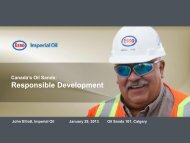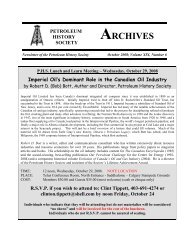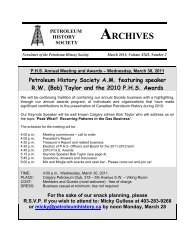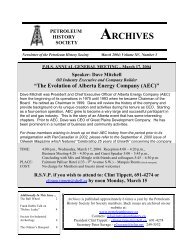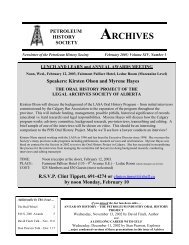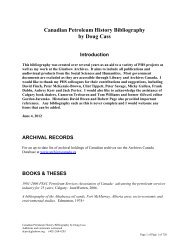PDF format - Petroleum History Society
PDF format - Petroleum History Society
PDF format - Petroleum History Society
You also want an ePaper? Increase the reach of your titles
YUMPU automatically turns print PDFs into web optimized ePapers that Google loves.
PETROLEUM<br />
HISTORY<br />
SOCIETY<br />
ARCHIVES<br />
Newsletter of the <strong>Petroleum</strong> <strong>History</strong> <strong>Society</strong> February 2006; Volume XVII, Number 1<br />
P.H.S. Lunch and Learn Meeting – Tuesday, February 21, 2006<br />
Speaker: B.A. (Sandy) Gow, Ph.D., Professor of <strong>History</strong><br />
on:<br />
The <strong>History</strong> of Drilling Safety in Alberta<br />
“You was either quick or you was dead”<br />
Sandy will be speaking to us about one aspect of his recently published book “Roughnecks, Rock Bits<br />
and Rigs”. This masterful account of the technological history of the drilling side of this industry in<br />
Alberta is, of course, far too much to condense into a short talk and Sandy has therefore selected one<br />
aspect of his publication for this purpose. To quote “Alberta’s early rigs were unsafe places to work.<br />
Our first gas well – really meant to be a water well for the C.P.R. – caught fire, exploded and produced<br />
injuries. Death and injuries were to dog Alberta drilling from the start, and the development of the<br />
Turner Valley Field – as well as some smaller fields before the end of World War II – accelerated this<br />
trend.” Sandy will touch upon the gradual trend to a more safety-conscious workplace leading up to<br />
the situation in 1970 that marks the end of his analysis.<br />
Sandy Gow studied <strong>History</strong> at the U. of A. and Dalhousie, as well as Education at U. Vic. and<br />
Mount St. Vincent. He currently teaches <strong>History</strong> at Concordia University College in Edmonton<br />
where he is continuing his research into the industry. Copies of the book will be available.<br />
TIME: 12 noon, Tuesday, February 21, 2006.<br />
PLACE: Fairmont Palliser Hotel (133 - 9 th Avenue S.W.) – Marquis Room (check marquee)<br />
COST: Members $25.00 and Guests $30.00 (most welcome) (cash or cheque only)<br />
R.S.V.P. if you wish to attend to: Clint Tippett, 691-4274 or<br />
clinton.tippett@shell.com by noon Monday, February 20<br />
Additionally In This Issue ...<br />
The Bull Wheel 2<br />
Earle Gray Appeal 4<br />
Imperial Oil’s Perspective on<br />
the Leduc Discovery 5<br />
Newfoundland Flying Boat<br />
Festival 6<br />
Archives is published approximately 6 times a year by the <strong>Petroleum</strong><br />
<strong>History</strong> <strong>Society</strong> for <strong>Society</strong> members. Back issues are archived on our<br />
website at:<br />
www.petroleumhistory.ca<br />
Contacts: info@petroleumhistory.ca<br />
President Clint Tippett – clinton.tippett@shell.com 691-4274<br />
Secretary Peter Savage - p2savage@telus.net 249-3532
THE PETROLEUM HISTORY SOCIETY<br />
THE BULL WHEEL<br />
Next Board Meeting: The Board will meet next on Thursday, February 23, 2006 at noon at the<br />
Glenbow Museum and Archives. Meet in the lobby just before noon.<br />
Volunteers: We are always on the lookout for people with the energy and dedication to help us<br />
grow and to undertake projects on the <strong>Society</strong>’s behalf. Please contact Clint Tippett (691-4274),<br />
Doug Cass (268-4203) or Hugh Leiper (249-0707) if you would like to get involved.<br />
Next Luncheons: Our luncheon slate for the Spring session is gradually filling up. We are<br />
always seeking speakers and interesting subjects. If you would like to consider presenting,<br />
please contact Clint Tippett, President P.H.S., at 691-4274 or Director Debbie Knall at 780-463-<br />
3859 (Edmonton). Our Annual General Meeting is scheduled for March 22 in the late afternoon.<br />
Canadian Centre for Energy In<strong>format</strong>ion: The P.H.S. has a “Content, Marketing and Traffic<br />
Partnership” with the Centre. This arrangement is an expression of the mutually beneficial<br />
cooperation that we hope will exist between our two organizations. Please see<br />
www.centreforenergy.com for more details. Of particular interest to our members is their on-line<br />
historical volume “Evolution of Canada’s Oil and Gas Industry” that can be downloaded free of<br />
charge.<br />
P.H.S. 2004 Awards: It had originally been our intention to present these awards during the<br />
February luncheon but it was decided to defer this event until the Annual General Meeting in<br />
March.<br />
Sad News: As many of you will know, Elsie Kerr, wife of P.H.S. Director Aubrey Kerr for sixtythree<br />
years, passed away on January 21, 2006. Elsie was well known to our membership and<br />
attended many luncheons with Aubrey. Her friendly smile will be missed. We pass along our<br />
deepest sympathies to Aubrey on behalf of the membership of our <strong>Society</strong>.<br />
Gow Invoices: For those of you who ordered a copy of Sandy Gow’s book through the <strong>Society</strong><br />
at the discounted rate, you should find herewith an invoice for the small amount of money owing<br />
to the <strong>Society</strong> as a result of the final cost of the book being somewhat higher than originally<br />
anticipated. This process for extra billing was anticipated at the time that orders were taken.<br />
<strong>Petroleum</strong> <strong>History</strong> <strong>Society</strong> Archives, February 2006, Volume XVII, Number 1 Page 2
P.H.S. Pin Sets: Our pin sets (of 6) have been reduced in price to $40.00. Please contact the<br />
<strong>Society</strong> if you are interested in buying one or several sets. These make great and original<br />
Calgary- or Western Canada-related gifts. Detailed comprehensive descriptions accompany<br />
each plush-boxed set.<br />
Membership Dues: Please note: At the September 15, 2005 meeting of the P.H.S. Board a<br />
motion was passed to alter the <strong>Society</strong>’s dues structure as follows effective January 1, 2006:<br />
1. New applications for the lifetime membership category will not be accepted. All lifetime<br />
memberships existing at that time will, of course, still be honoured.<br />
2. Individual memberships will increase to $25.00 per year from their current level of $20.00.<br />
3. Sustaining individual memberships will remain unchanged at $50.00 per year.<br />
4. Membership applications and renewals received before January 1, 2006 will be handled under<br />
the 2005 dues structure.<br />
Dues renewal invoices for 2006 are included with this month’s Archives.<br />
Turner Valley Gas Plant Status: The following is part of an announcement from Alberta<br />
Community Development released on November 16, 2005: “The site will remain closed to public<br />
use throughout the entire 2006 visitor season to allow for the construction of a permanent<br />
containment system. The containment system will prevent hydrocarbons and other contaminants<br />
from moving offsite and will allow for their remediation. It is expected to be in place by fall 2006.”<br />
As well, on January 17, 2006, a second press release was issued entitled “New Panel to review<br />
viability of Turner Valley Gas Plant”. This panel will be made up of 12 members and is called the<br />
“Turner Valley Gas Plant Resolution Advisory Panel” involving municipal, environmental and<br />
stakeholder representatives. As of press time, ten of these members had been announced with<br />
only the “members at large” still being un-named. At first glance, the panel seems light on those<br />
representing the historical side of the case although the Turner Valley Oilfield <strong>Society</strong> and the<br />
“Turner Valley Gas Plant Committee for a Safe Historic Site “ have delegates. An expression of<br />
interest has been made in support of some representation for the broader provincial and national<br />
aspects of preservation. Details are available on the Government of Alberta website.<br />
New Book: A new volume entitled “Athabasca Oil Sands – From Laboratory to Production – the<br />
letters of Karl A. Clark, 1950-66” has been released. It contains an introduction and selection of<br />
letters compiled by Mary Clark Sheppard. The book is available from Geoscience Publishing,<br />
Box 79088, Sherwood Park, Alberta T8A 5S3 and goes for $50.00 (plus $5.00 postage and<br />
handling) prepaid. Check also local bookstores such as DeMille’s at McNally-Robinson.<br />
New <strong>Petroleum</strong> <strong>History</strong> Course at the University of Calgary: Recent P.H.S. speaker and U.<br />
of C. lecturer Paul Chastko will be instructing a new course at the U. of C. entitled “<strong>History</strong> of the<br />
North American Oil Industry” during the Summer term of 2006. It appears to be catalog number<br />
1371 and will run on Tuesday and Thursday mornings at 9:00 a.m.. Consult the U. of C. website<br />
for more in<strong>format</strong>ion. Congratulations to Paul and the U. of C. for undertaking this long-expected<br />
teaching program.<br />
Alberta Centennial Stamps: Some of you may have noted a pane of 50 cent domestic stamps<br />
issued by Canada Post last year featuring so-called “Tallpecs” – striking landscape photos<br />
digitally stretched and elongated. The three used were shots of a Nova Chemical Plant,<br />
Calgary’s skyline and the CP mainline beneath Mount Grassi. Somewhat unusual for stamps<br />
was the presence of another series of pictures on the back of each pane. The one of particular<br />
interest to the P.H.S. was what was labeled “the Snowdon Oil Refinery of Calgary ca. 1912”. This<br />
is unusual as it predates Turner Valley. Does anyone have any background on this?<br />
<strong>Petroleum</strong> <strong>History</strong> <strong>Society</strong> Archives, February 2006, Volume XVII, Number 1 Page 3
Earle Gray Remarks at AGM March 23, 2005 re: Ontario Anniversary<br />
I want to avoid starting out like a speaker who began with this announcement: “Before I begin, I<br />
have something important to say.”. I mention that because I, too, have something to say before<br />
we get to the advertised subject of my talk. What I’d like to do is offer a challenge to the<br />
<strong>Petroleum</strong> <strong>History</strong> <strong>Society</strong>. I think you can expect that four years from now, the Americans will<br />
make a bit of a to-do about the 150th anniversary of the Drake discovery well at Titusville,<br />
Pennsylvania. The first oil well drilled in North America, they say; the oil well that gave birth to<br />
the petroleum industry. And you know that’s not right. You know that, more than anywhere else,<br />
it was in Canada that today’s petroleum industry was born, with Canadian parents. You know<br />
that the foundation was laid by that remarkable Nova Scotian - Abraham Gesner - with the<br />
process he developed to refine a liquid fuel from fossil fuels, a liquid he called kerosene.<br />
Produced first from coal at some three dozen coal oil refineries that sprang up overnight in the<br />
eastern United States, kerosene fuelled the lamps of the world for decades and today fuels jet<br />
aircraft. Even NASA, yes, the U.S. National Aeronautical and Space Administration, in its<br />
educational web site, has called Gesner “the father of the modern petroleum industry”. You know<br />
also that James Miller Williams brought in North America’s first commercial oil well at least a full<br />
year before Drake. William’s 1858 well at Oil Springs produced a daily volume of oil eight times<br />
greater than the Drake well, and there is evidence that suggests Williams drilled his first oil well<br />
not one, but two years before Drake. Williams did more than that. He was the first to refine<br />
kerosene from crude oil, as opposed to producing it from coal, undoubtedly with the help of<br />
Gesner. Within a few years, all the U.S. coal oil refineries had followed this lead and had<br />
switched from coal to crude oil for their feedstock. Williams also established the first integrated<br />
oil producing, refining and marketing business. As historians, we know all this. But very few<br />
other Canadians know it, and even fewer Americans.<br />
So the challenge is this, what can we do to gain wider recognition for Canada’s pioneering<br />
contribution to the development of the petroleum industry? I can think of two things. First, let’s<br />
see if we can persuade Canada Post to strike a postage stamp in 2008 -- less than three years<br />
from now -- that would mark the 150th anniversary of North America’s first known commercial oil<br />
well. Secondly, I know from Bob Bott that a joint meeting with the U.S. <strong>Petroleum</strong> <strong>History</strong> Institute<br />
in 2007 or 2008 has already been discussed. I would encourage you to make it 2008, in<br />
southwest Ontario, where North America’s oil production began.<br />
At Oil Springs, you can view operations at the world’s oldest producing oil field, where hundreds<br />
of wells are still pumping a tiny trickle of oil after 147 years - 150 years if you meet there in 2008.<br />
Moreover, they are still produced by the rod-and-jerker system developed by John Henry<br />
Fairbank in 1863. His great-grandson, Charlie Fairbank, still uses that system to pump about<br />
25,000 barrels of oil a year from some 350 wells. Too often we Canadians fail to recognize our<br />
heritage until someone else points it out. That could be the case at Oil Springs where an<br />
American, Dr. Emory Kemp, a professor of industrial archeology at the University of West<br />
Virginia, has mounted a campaign to have this producing field declared a World Heritage Site by<br />
the United Nations. Perhaps the <strong>Petroleum</strong> <strong>History</strong> <strong>Society</strong> could lend some support to that<br />
effort.<br />
I can’t imagine why anyone interested in the history of Canada’s oil industry would not welcome<br />
an opportunity to see how oil was actually produced a century and a half ago. And I suspect that<br />
Charlie Fairbank would be pleased to show it to you. So this is what I wanted to say before I<br />
begin. And I thank you for bearing with me.<br />
<strong>Petroleum</strong> <strong>History</strong> <strong>Society</strong> Archives, February 2006, Volume XVII, Number 1 Page 4
THE STORY OF LEDUC NO. 1 –<br />
It drilled to a depth of 118 miles and took 28 years to complete<br />
(From the Financial Post Survey of Canadian Oils for 1948 – an advertisement by Imperial Oil Limited)<br />
“It was a devious hole! It spudded in as a cable tool test at Czar, in eastern Alberta in 1919. It sampled<br />
the strata at Wainwright, Ribstone, Red Coulee, Tilley, Vermilion, Princess and a host of other Alberta<br />
locations. It wandered over into Saskatchewan. It had tough drilling at Stolberg, Coalspur, Wildcat Hills,<br />
Grease Creek, Jumping Pound and numerous foothill structures. It had to case off a tremendous gas flow<br />
at Kinsella but otherwise it just got inadequate showings of oil! The final 5,000 feet of drilling was done by<br />
rotary at Leduc and production was obtained in the Devonian limestone! That, literally, is the story of the<br />
Leduc Discovery Well. It was not a promiscuous “wildcat” that met with immediate success. It was the<br />
culmination of years of systematic effort. It was the lineal descendant of 622,600 feet of exploratory<br />
drilling. It was the fruits of an expenditure of millions of dollars.”<br />
“Western Canada has 500,000 square miles of prospective oil territory. Imperial Oil geologists started<br />
back in 1919 to look for a Leduc in that vast area. As the science of oil finding progressed they were<br />
joined by geophysicists with their gravity meters and seismographs; the core drillers with their portable<br />
rigs; the palaeontologists with their microscopes; each applying his specialized knowledge to the problem<br />
of where to drill. They were not always right; many disappointments inadequately rewarded the efforts of<br />
the drillers who, surmounting the difficulties of climate and terrain, drove their test holes to ever greater<br />
depth. But Imperial’s toolpushers, like Oliver Twist, always came back for more and at Leduc they got<br />
their reward.”<br />
Section of an oilfield painting by Franklin Arbuckle, Shell Canada Collection, not in ad<br />
“Imperial Oil is in the oil business in Canada from coast to coast. To serve its customers it must supply its<br />
seven refineries with crude oil. The farther it has to go for crude, the heavier the transportation charges<br />
are and these, of course, are part of the cost of the finished products. Only one out of every ten barrels<br />
processed in Canadian refineries comes out of a Canadian well. Some of the imported barrels have<br />
accumulated over $2.00 of transportation charges before they go into the cracking coils. That and the<br />
saving of foreign exchange are strong reasons for trying to boost Canada’s domestic production. Who will<br />
benefit from Leduc? Here is how Mr. H.H. Hewetson, President of Imperial Oil Ltd. summed it up for the<br />
Company’s shareholders at their last General Meeting: “I need not comment on how good an enlarged<br />
production of oil in Canada would be for all segments of the national economy. It would mean an addition<br />
to the national income and, in the course of time, with production at a sufficient level, it would mean also a<br />
reduction in the cost of petroleum products to consumers on the prairies. This, of course, would also be a<br />
very important contribution to the national wellbeing because it would eventually lower the cost of<br />
production for our great agricultural industry.””<br />
<strong>Petroleum</strong> <strong>History</strong> <strong>Society</strong> Archives, February 2006, Volume XVII, Number 1 Page 5
Newfoundland Flying Boat Festival going International<br />
The central Newfoundland, Canada towns of Botwood and Norris Arm, and the Town of Foynes, Ireland<br />
are exploring partnership opportunities for the Flying Boat Festival International (F.B.F.I.) that is being<br />
organized for the summer of 2007. A celebration of the well-known Flying Boat era that saw hundreds of<br />
non-stop Atlantic crossings between Botwood and Foynes, the F.B.F.I. project also includes newly<br />
developed infrastructure and attractions in the two Bay of Exploits communities. Initial consultations with<br />
representatives of the Foynes Flying Boat Museum have been met with an enthusiastic response.<br />
Communications have been ongoing for a number of months via e-mail, and this past Sept. a conference<br />
call was held between local F.B.F.I. committee representatives and members of the Foynes Museum<br />
Board of Directors. Foynes representatives have been asked to consider a cultural exchange, including:<br />
music and other forms of entertainment, food, crafts, reciprocal pavilions and dignitary visitations. A new<br />
web site for the festival was launched in Nov. - www.flyingboatfestival.ca. The site has already received<br />
responses and enquiries from aviation enthusiasts, and festival coordinators are in the process of making<br />
contact via email with hundreds of flying boat and aviation organizations and devotees throughout North<br />
America and around the world. A prelude of the festival will take place in early August of this year and will<br />
include activities in both Botwood and Norris Arm.<br />
In 2007 the main celebration for the FBFI will be held as this year marks the 70th anniversary of an<br />
important event in aviation history. On July 5, 1937 two flying boats - one eastbound from Botwood and<br />
the other westbound from Foynes - were each successful in their attempts to traverse the Atlantic Ocean<br />
non-stop. This event is said to have heralded a new era in human connectivity. Although experimental,<br />
these first triumphant flights were touted as a tremendous feat by the media of the day. They led to a<br />
short, but colourful, period in aviation history that included 492 scheduled flying boat Atlantic crossings<br />
between 1939 and 1945. [editor’s note – Shell aviation fuel was central to these flights as depicted above.<br />
Promotion of the role of high quality aviation fuels was a major marketing component in those days.]<br />
At a time when Britain, and later the U.S., were inevitably being drawn closer to a formal declaration of<br />
war, and during WW2 itself, the Ireland-Newfoundland flying boat connection was the central part of an<br />
important transportation route starting in Port Washington, New York, through the Bay of Exploits, and<br />
ending in South Hampton, England. Dignitaries and entertainers such as Winston Churchill and Bob Hope<br />
were among those who traveled between North America and Europe via flying boat.<br />
The new Central Newfoundland celebration will bring to life the vision of a group of dedicated individuals<br />
from Botwood and Norris Arm who have put in countless volunteer hours since Dec. of 2002. Norris Arm's<br />
involvement in the F.B.F.I. stems from its aviation history and its link to Botwood. Meteorological survey<br />
work for the British Air Ministry was carried out from Norris Arm in the early to mid 1930's. This included<br />
work required before non-stop flights across the Atlantic could be attempted.<br />
<strong>Petroleum</strong> <strong>History</strong> <strong>Society</strong> Archives, February 2006, Volume XVII, Number 1 Page 6



